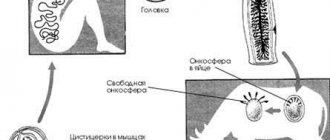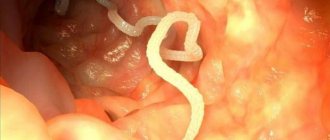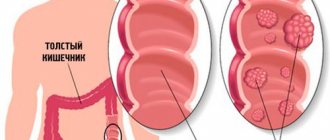Where do worms come from?
Ways of infection with worms:
- Oral-fecal. The mechanism of transmission of the pathogen is when helminth eggs enter the human body with contaminated food contaminated with water. Parasites transmitted this way are localized mainly in the intestines, going through the full development path. Adult worms release their eggs out along with the host's feces in order to later obtain another carrier. Characteristic of nematodes and cestodes.
- Eggs entering through the soil. Transmission of helminths by this route is characterized by direct contact of the future host with the soil. The transmission mechanism is similar to the oral-fecal one, but eggs can land on the soil not only with feces, but with sputum, saliva, urine, and other carriers (ticks, fleas, lice), which carry the larvae and eggs of parasites on their bodies. Nematodes and cestodes are transmitted in this way.
- Hematogenous. With this method of transmission, worms enter directly into the bloodstream through insect bites. The eggs of helminths are swallowed by bloodsuckers, the larvae hatch in their womb, they migrate to the proboscis and, together with the bite, enter the host’s body. In this way, a dangerous disease is transmitted - dirofilariasis, the causative agent of which is localized in the cavities of the heart.
- Biohelminthiasis. Characteristic of parasites that have several temporary hosts and one definitive host. There are several stages of development in animals, after which humans become infected through various routes of transmission. Trematodes are transmitted in this way.
Infestation detection test
A helminth infestation goes unnoticed only for a short period of time, but even after the symptoms appear, not a single doctor will be able to name the exact helminth that is bothering a person. In order to determine the presence of worms, special laboratory tests are required. If laboratory testing is not possible, you can use a small test for a conditional diagnosis, which will be confirmed in the future by a specialist. Signs of helminth infection, which together confirm the diagnosis:
- abdominal pain, itching in the perineum and anus;
- any skin allergies;
- dizziness and migraines;
- problems with stool (diarrhea, bloating, constipation);
- constant state of anxiety;
- swollen lymph nodes;
- temperature increase;
- joint pain;
- weight loss.
A person concerned about his own health should conduct a survey (note the number of symptoms that occur). Positive answers are a signal to see a doctor. Treatment of helminthiasis is not carried out without an accurate diagnosis, because helminthiasis does not always manifest itself typically or in the same way for adults or children. It is necessary to get rid of helminths, but only under the supervision of a specialist. Helminths in humans are a real threat. Signs of various types of worms in humans and symptoms of their presence only precede serious diseases of the internal organs.
Signs of worm infestation
When parasites enter the human body, the first thing that suffers is the immune system, which does its best to expel unwanted guests.
General deterioration begins:
- lethargy;
- apathy;
- insomnia;
- chronic fatigue;
- dizziness.
These signs are associated with a lack of nutrients and vitamins that the worms absorb. The immune system does not act immediately on some types of parasites. With the accumulation of infestation, specific symptoms for each helminth and specific symptoms of damage to each organ begin to appear.
Parasites in the liver
Parasites enter the liver through the fecal-oral or hematogenous route, when the larvae migrate with the bloodstream to various parenchymal organs.
Symptoms:
- Temperature increase by 1-2 degrees. With severe infestations, when parasites cause necrosis and abscesses, the temperature can rise to 40-41 degrees.
- Manifestations of yellowness of the mucous membranes and skin are considered a general sign of liver damage, and therefore a lot of bilirubin is produced.
- Increase in organ volume, change in consistency. The liver literally protrudes above the abdominal cavity and puts pressure on the surrounding tissue. There is pain in the right hypochondrium, difficulty breathing, abdominal pain.
- Laboratory tests show an increased level of eosinophils in the blood.
- Nausea, vomiting, dizziness associated with liver dysfunction and accumulation of intoxication.
Parasites in the intestines
The intestines are the favorite habitat of sexually mature worms. There they feed, reproduce, and have a way of releasing eggs into the environment using the host's excretory system.
Symptoms:
- General digestive disorders: vomiting, diarrhea or constipation.
- Loss of appetite.
- Perverted appetite - a person strives to eat something that is usually not typical for him: abuse of sweet, fatty, meat, often undercooked. This is due to the fact that the body tries to supplement those nutrients that the worms deprive.
- Presence of blood in stool.
- Severe abdominal pain.
- Intestinal blockage.
- The presence of helminths in feces and vomit.
Parasites in the lungs
Parasites enter the lungs along with the bloodstream from the intestines or other organs. These are mainly larvae. Some die under these conditions, while others take root and cause serious damage to the respiratory system.
Symptoms:
- Chest pain.
- Severe cough with sputum.
- Temperature increase.
- Wheezing.
- Difficulty breathing.
With severe invasion, severe complications may appear: bronchitis, bronchopneumonia, obstruction of the respiratory tract, necrosis and abscesses of the lung tissue.
Parasites in the eyes
The larvae of parasites can be localized in various membranes of the eye, causing severe damage to vision. Some helminths grow to a sexually mature stage.
Symptoms:
- The presence of dense visible nodules under the eyelid.
- Pain in the eyes.
- Sensation of “moving” in the eyes.
- Sudden loss of vision.
- Protrusion of the eyeball from the orbit.
- Developing strabismus.
- Discharge from the eyes.
Parasites in the brain
The presence of parasites in the brain is considered one of the most dangerous, since worms devour invaluable nerve tissue. In most cases, parasitic diseases of the brain lead to death.
Symptoms:
- Constant headache, migraine.
- Dizziness.
- Nausea and vomiting.
- Sudden appearance of psychoneurological disorders.
Symptoms of worms depending on the type of helminth
Symptoms of helminthiases directly depend on the type of parasite, its location in the body and the intensity of infection. How quickly do signs of worms appear after infection? So, for example, already 2-3 days after infection with roundworms, a person may experience a deterioration in their general health, in most cases of infection with other types of helminthiasis - the first symptoms of worms in a person appear after 2-3 weeks, and diseases such as filariasis have an incubation period period 6-18 months.
The danger of infection with intestinal worms is that in the presence of a single individual in the intestine, helminthiasis is often asymptomatic. Any symptoms can appear only when the worm is huge, for example, tapeworm or roundworm, or when there is a massive infection.
Pinworms or enterobiasis - in addition to the typical, main signs of any helminthiasis, the most characteristic symptoms of enterobiasis are itching in the anus, worsening at night. Also a factor in the presence of a small number of pinworms is the frequency of such itching, if it occurs only for 1-2 days, then goes away and after a couple of weeks it repeats again. This is an important sign of the presence of pinworms; with severe infestation, the itching may be more constant.
Trichocephalosis, hookworm disease, diphyllobothriasis, schistosomiasis - contribute to the development of vitamin deficiencies and anemia, since the poison of helminths and the metabolic products they secrete greatly change the intestinal microflora, causing intestinal dysbiosis, promoting the proliferation of opportunistic microorganisms.
Roundworms - the symptoms of ascariasis depend on the phase of development of helminths, if this is the initial phase, when the larvae migrate through the blood to the lungs and other organs, then helminthiasis first manifests itself as low-grade fever, weakness, dry cough with mucopurulent sputum, possibly even with blood, on x-ray volatile infiltrates appear in the lungs within 1-2 weeks, which then disappear. Blood tests show a high percentage of eosinophils, allergic reactions appear. With severe infestation, the development of bronchitis with attacks of suffocation and pneumonia is possible. In the 2nd late phase - intestinal, gastrointestinal dysfunction already occurs. Roundworms secrete substances that neutralize human digestive enzymes - pepsin and trypsin, without which it is impossible to digest proteins, so with ascariasis a person loses a lot of weight. Complications of ascariasis can include obstructive jaundice, pancreatitis, intestinal obstruction, and acute appendicitis.
Almost all helminthiases are characterized by central nervous system disorders - headaches, dizziness, increased irritability, fatigue.
Trichinosis - most often manifested by muscle pain, fever, swelling of the face and eyelids
Fascioliasis, opisthorchiasis, clonorchiasis - liver trematodes, appear with the appearance of jaundice syndrome (see symptoms and causes of jaundice), also enlarged spleen, liver, pancreatitis, neurological disorders, cholecystocholangitis, gastrointestinal pathologies.
Strongyloidiasis is characterized by a wide variety of symptoms - allergic reactions, pathologies of the biliary tract, and dyspeptic disorders.
Urogenital schistosomiasis - causes diuretic disorders, manifested by the release of blood at the end of urination.
The most common types of parasites
Various types of worms can live in the human body: flukes, nematodes and cestodes. Some species are easy to catch, others appear once. Some parasites are considered common to humans and animals, while others prefer to live only in certain hosts.
The most common types of parasites:
- Ascariasis. The helminth that causes this disease lives only in humans and is localized in the small intestine. The causative agent is the human roundworm, a white nematode up to 30 centimeters long. Symptoms are typical for damage to the digestive and respiratory organs. They enter the body through the oral-fecal route.
- Teniarinhoz. A disease caused by bovine tapeworm, a type of tapeworm. Enters the body through the oral-fecal route, or through contaminated beef. In the human body, the worm grows up to 10 meters and causes serious damage to health. Manifests itself with symptoms typical of intestinal disorders.
- Fascioliasis. This disease is caused by the liver fluke, a member of the trematode genus. Going through a complex life cycle, the pathogen is localized in the liver and bile ducts of humans and animals.
- Echinococcosis. The disease is caused by the larval stage of alveococcus (cestode) and enters the human body through the oral-fecal route. The larva enters the human body and is localized in various organs and tissues, attaching to which it forms cysts. The disease is difficult to diagnose and treatment is often only surgical. Symptoms of echinococcosis in humans are covered here.
- Trichocephalosis. This is a very common disease in humans. The parasite is a round worm with a characteristic thread-like part of the body, for which it received the name whipworm. It is localized in the intestines and causes typical intestinal disorders.
Folk remedies for worms in adults
Traditional methods only complement basic drug treatment. To do this, you need to use only well-tested natural ingredients and recipes. It is better to buy all the ingredients at a pharmacy or from trusted healers.
Garlic enemas. The solution for the procedure is prepared as follows: add 6 cloves of peeled and well-chopped garlic to a glass of water. Leave for two hours.
Wormwood extract. A teaspoon of the dry crushed mixture is poured with two glasses of boiling water. The mixture is cooled well. For sweetness you can add a spoonful of honey. Take 3 times a day.
There are many effective folk remedies in the fight against worms, but all of them should be in addition to the main treatment
Collection of tapeworms. Taken twice: first thing in the morning and before bed. Main ingredients: wormwood, buckthorn, wild carrot, mint, valerian. The course of treatment with this collection is 3 days.
Pumpkin seeds - help get rid of tapeworms. Raw seeds are cleaned and finely crushed. Pour two glasses of water and add a spoonful of honey. Mix all this well and take a teaspoon for an hour. After a couple of hours you need to give a cleansing enema.
What tests need to be taken?
If a person suspects that he has a helminthic infestation, he can contact a therapist for testing.
After collecting symptoms and medical history, various diagnostics are prescribed, for example:
- Stool analysis. This method makes it possible to identify worm eggs in human feces, parasitizing in different parts of the intestine. With coprogram, it is possible to identify the type of helminthiasis and then prescribe effective treatment.
- Blood analysis. A general and biochemical blood test allows you to see the presence of inflammatory processes that are caused by parasites, as well as identify special antigens and antibodies inherent in a particular worm.
Additional research methods:
- An X-ray examination is prescribed to examine the lungs for the presence of helminthiasis in the lung tissue. The image shows fine-grained inclusions, which, together with the rest of the diagnostics, allows us to make a correct diagnosis.
- Ultrasound examination is used to determine the presence of specific helminthiases such as echinococcus.
How can you tell if your child has parasites?
The process of helminthiasis in a child’s body is difficult to diagnose based on the child’s words. Since children cannot yet answer questions accurately, the only way to determine whether a child has worms is through a stool test.
However, parents should be aware of what bad symptoms may indicate the presence of parasites in a child.
First of all, the baby may experience changes in behavior. He becomes moody and restless. On the other hand, if a child becomes lethargic, apathetic, gets tired quickly, and loses interest in games and studies, this is also a reason to worry.
There are a number of signs that cannot be determined immediately. Brittle nails and hair, increased salivation, peeling of the skin - all these can be symptoms of the presence of worms in the child’s body.
The most likely symptom of helminthiasis is when the baby scratches his butt. It often happens that helminths, especially pinworms, come out of the anus. This process mainly occurs during sleep. If parents notice worms in the children's potty or on things, they should immediately consult a doctor.
Common signs of advanced helminthic infestation
Typical signs of the long-term presence of worms in the body are symptoms of general intoxication, combined with signs of digestive disorders, allergic reactions and a weakened immune system. These include:
- Skin rashes.
- Lethargy, headache, migraine.
- Feeling of heaviness in the stomach after eating.
- Painful cramps in the abdomen.
- Nausea, rarely vomiting.
- Bad breath.
- Weight fluctuations (sudden weight loss or weight gain).
- Discomfort in the anus.
- Diarrhea followed by constipation.
- Frequently recurring colds and viral diseases (as a result of decreased immunity).
- Anemia.
- Painful urination.
- Miscarriages and menstrual irregularities in women.
- Children have developmental and growth delays.
- Problems with memory and academic performance.
Helminths can live not only in the intestines. When parasites settle in the lungs, the signs of the appearance of worms will be as follows: fever, shortness of breath, cough, sputum containing blood. There will be obvious wheezing when listening to the lungs. Any infection transmitted by airborne droplets easily attaches to such a patient.
Echinococci, settling in the liver, cause dysfunction of this organ and the appearance of “liver” symptoms.
Thus, worms have a fairly strong negative effect on the whole organism, causing various symptoms. Helminthiasis is difficult to treat with medication, so treatment should begin immediately after diagnosis.
Which doctor should I contact?
If you suspect parasitic diseases, it is first of all better to contact your physician for testing. If helminthiasis is confirmed, then the same therapist can prescribe treatment, since the drugs are divided into anti-trematode, anti-cestodose and anti-nematode substances.
In some cases, due to the specificity of some parasites, as well as the characteristics of the body (for example, pregnancy), the patient is prescribed a consultation with a parasitologist. He prescribes the most appropriate treatment, as well as restoration of the body after expelling the parasites.
HOW IS HELMINTHISIS TREATED?
What causes worms in adults has been described in detail above. Depending on the type of parasite, appropriate medications are prescribed. To treat enterobiasis, drugs that include mebendazole are used. You can also resort to a folk remedy - use pumpkin seeds.
Filariasis (infection with filarial filaments) is perfectly treated with diethylcarbamazine tablets.
Medications containing levamisole are prescribed in case of diagnosis:
- hookworm;
- ascariasis;
- strongyloidiasis;
- necatoria;
- trichocephalosis;
- trichostrongylosis;
- toxoplasmosis;
- enterobiasis.
When roundworms are found in the human body, and the doctor makes a diagnosis:
- hookworm,
- ascariasis,
- trichocephalosis,
- trichostrongylosis
For treatment, drugs containing bephenium hydroxynaphthoate are prescribed. You can also use pumpkin seeds.
How to get rid of worms in adults when enterobiasis or ascariasis is detected? Taking piperazine adipate shows great effect.
Tablets containing albendazole work well against echinococcus or cysticercosis.
For the treatment of diseases such as:
- cestodosis;
- trematodosis;
- schistosomiasis;
- paragonimiasis
Doctors prescribe drugs with praziquantel for people. Some patients additionally use pumpkin seeds.
If severe exacerbation is observed, appropriate procedures are prescribed:
- infusion;
- injections.
Prevention of helminthic infestation
Prevention of helminthic infestation:
- Rinse fruits and vegetables with water before eating.
- Drink only boiled or distilled water.
- It is advisable to always fry and boil meat from trusted producers, since a new law has been issued on strict veterinary control of all livestock products. Therefore, it is difficult to find parasites in meat purchased in the supermarket. It’s a different matter for meat purchased from private owners. The same applies to fish products.
- Preventive deworming of animals and all family members. It is necessary to carry out every 3-6 months.
- Avoid contact with other people's pets, including homeless ones.
- Follow the rules of personal hygiene: washing your hands before each meal, after interacting with animals, and coming from outside. Also keeping the house clean.
Additional reasons
Why do worms appear and how to prevent it? Infection with parasites can also occur due to poor personal hygiene, especially by children. It is very dangerous when a child plays in the sandbox and puts his hands in his mouth. He can pick up not only E. coli, but also dangerous types of helminths, the eggs of which are found in animal feces.
Attention to the personal hygiene of the child
If a child develops a high fever, nausea, vomiting, and loses weight before our eyes, then these are the first symptoms of helminth infection. In this case, it is better not to delay visiting the doctor. Worms can also appear through contact with pets. Some people are beginning to refute this possibility, claiming that cats never leave the house. However, worm eggs are very easy to carry on shoes, and pets always lick themselves, introducing the larvae into the gastrointestinal tract.
After contact with a cat or dog, you must wash your hands thoroughly. It is unacceptable for an animal to eat food from a child’s or adult’s plate.











